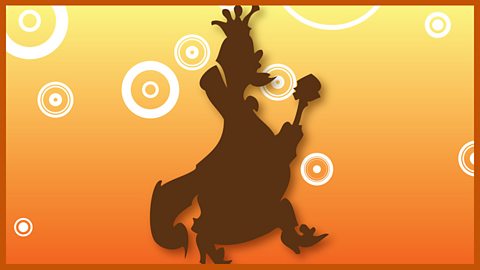Once there was a woman who longed for a child of her own. So she went to a witch to ask for help. ‘Old witch,’ she said. ‘I would dearly like to have a child of my own. Can you help me?’
‘Ah, that’s easy,’ said the witch. ‘Here’s a barleycorn for you. Take it home and plant it in a pot. Then wait and see what happens.’‘Oh thank you,’ said the woman. She hurried home and planted the grain in a pot. At once a flower began to grow.
‘What a pretty flower,’ exclaimed the woman and she bent down to kiss the petals. As she did, the petals burst open.There, sitting in the middle of the flower, was a little girl. ‘How tiny and delicate she is,’ said the woman. ‘Why, she is no bigger than the tip of my thumb. I will call her Thumbelina.’
Thumbelina was very contented. At night she slept under a rose petal in a polished walnut shell. By day she rowed herself across a bowl of water the woman had put out for her.
As she rowed she sang. She had the sweetest voice you’ve ever heard. One night, while Thumbelina was asleep, a toad hopped through the window. ‘Now there be a handsome wife for my son,’ the big wet toad croaked, thumping down onto the table where Thumbelina lay.
She picked up the walnut shell and hopped with it back to her home in the mud by the edge of a stream.
But ‘Croak croak, brek-kek-kex,’ was all the toad’s son said when he saw Thumbelina. ‘Shhh! Don’t speak so loudly. You might wake her,’ his mother said. ‘We must put her somewhere where she cannot escape. I know,’ she said, when she had thought for a time. ‘I’ll put her on a water lily out in the stream.’
So Toad swam out to the centre of the stream and set the walnut shell down on the leaf of the biggest water lily. When Thumbelina woke and saw where she was, she began to cry. All she could see around her was water. ‘How will I ever get back to land,’ she said sadly.
Back on the bank the toad was very busy, carrying rushes and yellow water flowers from the stream to decorate the room where her son and his bride would live. ‘How happy my son and his new bride will be,’ she thought.
Then the toads swam out to the leaf in the stream where Thumbelina was perched. The old toad made a deep bow to Thumbelina. ‘This is my son,’ she said. ‘You are to marry him and live with him in our fine house under the mud.’
‘Croak croak. Brek-kek-kex,’ was all that her son could say. After the toads had swum away Thumbelina sat and cried on the leaf. ‘I do not want to marry a big ugly toad and live in a house with him under the mud,’ she said.
Below the lily the fishes heard her and popped up their heads to look at her. ‘What a pretty little girl,’ they said to each other. ‘We cannot let her marry an ugly creature like that.’ So they swam up to the stalk that held the leaf and gnawed away at it until at last the lily floated free.
Down the stream the lily glided. Thumbelina was happy. ‘The toads will never catch me now,’ she thought. The sun shone brightly and the water glittered like gold. She did not see the beetle fl y overhead. Then all of a sudden she felt a pair of claws grip her around the waist and lift her off the lily leaf. Up the beetle fl ew into a tree, Thumbelina still clasped tightly in its claws.
Thumbelina was very frightened but there was nothing she could do. The beetle put her down on a large leaf. ‘You are very pretty,’ it said. The other beetles who lived in the tree came to look at her. ‘Why, she has only got two legs,’ scoffed one. ‘And she hasn’t got any feelers,’ snorted another, waving his about proudly. ‘And look how thin her waist is. Ugh! She is not pretty – not pretty at all,’ they said. The beetle who found her decided that they were right and so Thumbelina was put back down on the ground.
All summer Thumbelina lived alone in the forest. She wove herself a bed out of blades of grass and hung it like a hammock under a dock leaf to shelter from the rain. When she was hungry she ate honey and pollen from the flowers. And when she was thirsty she drank the early morning dew off the leaves. But summer passed and the days grew colder.
The birds who had sung in the trees fl ew away. The leaves withered and dropped and Thumbelina shivered with cold. Snow began to fall. Every snowflake that fell felt like a shovelful on tiny Thumbelina. She wrapped herself in a dry leaf but that did not warmher.
Wandering about, Thumbelina found herself at last outside the forest, in a cornfield. The corn had been cut and only stubby stalks were left in the frozen ground. There among them she saw a door. Behind it, in a cosy little house, lived a field-mouse.
‘Please, may I have a piece of barleycorn to eat,’ Thumbelina begged the field-mouse. ‘I have had nothing to eat for two days.’‘You poor thing,’ said the field-mouse, who had a kind heart. ‘Come inside! Come inside!’ The field-mouse so enjoyed Thumbelina’s company that she told her she could stay. ‘But you must clean my house and tell me stories,’ she said.’ I like to listen to stories.’
One day the field-mouse told Thumbelina that her neighbour – a mole - was coming to visit them. ‘He is very rich and clever,’ she told Thumbelina. ‘He would make you a fine husband. He cannot see very well, but he lives in a big house and wears a black velvet coat.’
Thumbelina didn’t care how rich and clever he was. She didn’t want to marry a mole. But when the mole came to visit, she sang so sweetly that the mole fell in love with her.
But he was cautious and said nothing to Thumbelina. He told them he had dug a passage that linked their houses together. ‘You may go along it whenever you like,’ he said. ‘Follow me, and I will show you the way.’ He took a piece of rotten wood which glowed in the dark, and led them along the tunnel.
‘There is a bird in the passage,’ he told them. ‘But don’t be afraid, for it is dead.’ When they reached the place where the bird lay, the mole thrust his nose up through the ceiling to let in the daylight.
Now they could see the bird clearly. It was a swallow, its beautiful wings pressed close against its sides, its legs and head huddled into its feathers. Thumbelina felt so sorry for it, but the mole shoved the bird aside with his stubby legs. ‘There’s one we won’t have to listen to any more,’ he said. ‘I don’t like birds. They make an awful din!’ ‘Quite right,’ said the field-mouse. ‘Yet everyone thinks so highly of them. I cannot think why.’
Thumbelina said nothing, but as soon as their backs were turned, she bent down and gently parted the feathers on the swallow’s head and kissed its closed eyes. ‘Perhaps this is the bird that sang so sweetly to me in the summer,’ she thought. ‘How happyits song made me.’
That night Thumbelina could not sleep. So she got out of bed and plaited a small blanket of hay. Then she crept back down the passage and spread it over the bird. ‘Farewell, pretty bird,’ she said. ‘Thank you for singing to me in the summer, when the trees were green and the sun shone all day.’ Then she laid her head on its heart.
Knock! She heard. Knock. Knock. She jumped back, startled. The bird’s heart was beating. It was alive. Thumbelina was frightened. The bird was so big and she so small. But she tucked the little blanket closer over the bird’s head to warm it. The next night she came back to see the bird again. It opened its eyes. ‘Thank you,’ it said faintly. ‘You have saved my life. Soon I will be able to fly away.’
‘No!’ insisted Thumbelina. ‘It is too cold outside for you to leave. Stay here. I will look after you.’ All winter long the bird stayed in the passage. Then spring came and it flew out of the hole in the roof.
Thumbelina was very sad as she watched it fly away. She had grown very fond of the bird. And the sight of the sun saddened her, for she rarely saw it now. ‘You are to marry the mole,’ the field-mouse told her one day. Thumbelina felt very sad. She did not like the mole at all. He did not care for the things she did. He liked the dark and she liked the sun. She did not want to live under the ground in the dark.
The day of the wedding arrived. Thumbelina stood in the doorway to look at the sunshine one last time. She heard a bird sing in the sky overhead. It was the swallow. How happy they were to see each other again. ‘Come away with me,’ the swallow said when Thumbelina had told him her sad tale. ‘I will take you to a land where the sun always shines.’
Thumbelina climbed up on to the swallow’s back, and tied her sash to one of his feathers, and away they flew, up over trees and lakes and snowy mountains where the air was so cold that Thumbelina shivered and crept under the swallow’s feathers for warmth.
Then she felt the air grow warmer. Below her now she could see waving palms and the air was sweet and full of butterflies. Down the swallow fl ew and landed on the ground near the pillars of a marble palace. Vines twisted up its columns. Swallows flew back and forth.
One of the columns had fallen and lay on the ground, in pieces. In between the broken pieces, beautiful white flowers grew. ‘My nest is high up on a marble column, but you will be better down here, on one of these flowers,’ the swallow told Thumbelina. ‘I should like that,’ Thumbelina said.
The swallow set her down gently on one of the flowers. There, in the middle of its petals, stood a little prince, a gold crown on his head. He was as fine and delicate as Thumbelina herself. Shining wings sprouted from his shoulders. He was the king of the flower people. In every flower a tiny person lived, and he was the king of them all.
‘He’s very beautiful,’ Thumbelina thought. ‘Isn’t she lovely,’ thought the prince. ‘I would like to marry her.’ He took the crown from his head and put it on hers. ‘Marry me and be queen of all the flowers,’ he said. Thumbelina was so happy. All the flower people brought her presents. One of them fixed wings to her back so that she could fly from flower to flower like them. ‘You shall not be called Thumbelina any more,’ the prince said to her. ‘Your name will be Maia.’
That summer the swallow bid a sad farewell to Thumbelina and fl ew back to his nest under the window of a teller of fairy tales. ‘Listen,’ he said to him, ‘I have a tale to tell you.’ And that is how we come to know the story of Thumbelina.
Synopsis
Anne-Marie Duff reads an adaptation of 'Thumbelina' by Hans Christian Andersen.
A tiny but beautiful girl grows from a barleycorn which has been enchanted by a witch. She is found when a woman kisses the petal on the flower and she is named Thumbelina on account of her size. She is kidnapped by a toad who wants her to marry her son and is left on a lily pad. Fish rescue her by gnawing the lily pad loose so that it floats downstream but Thumbelina is once again snatched away, this time by a beetle. She is later abandoned by the beetle, after other beetles convince him that Thumbelina is ugly because she is not like them.
When winter comes Thumbelina is dying of cold and starvation before being taken in by a field mouse. The field mouse's neighbour is a blind mole who falls in love with Thumbelina because of her beautiful singing voice. In a passage he has dug between the field mouse's home and his own, the mole finds a swallow who he believes to be dead. Indeed the mole is happy the bird is dead because he thinks birds make a terrible noise. Thumbelina disagrees and nurses the bird back to life.
Later the mole proposes marriage to Thumbelina and the field mouse believes that she should marry the mole on account of his wealth. However, Thumbelina does not want to live underground and when taking a last look at the sunshine above ground on the day of her wedding, she is rescued by the swallow who takes her to a beautiful field of flowers. Here she meets the Prince of the Flower People and agrees to marry him. She is given a pair of wings so that she can fly with the rest of the flower people.

Ã˝
Ã˝
Curriculum guidance
Tales of Hans Christian Andersen can be used to target a range of Reading and Writing objectives from the KS2 National Curriculum programme of study for English across Y3 to Y6 in England, Wales and Northern Ireland and Second Level of the Curriculum for Excellence in Scotland. Specific objectives include increasing pupils’ familiarity with a range of texts ‘including fairy stories’ and ’traditional stories’.
Pupils have the opportunity to listen to and read a selection of Andersen’s stories - especially adapted for the age group - and respond through a range of speaking and writing activities. Full details of curriculum links and follow up activities are included in the Teachers’ Notes.
Some of Hans Christian Andersen's tales have a dark and pessimistic theme. This means that careful selection of texts is required to ensure age-appropriateness. Please see the teachers' notes below for full synopses and suggestions for use in the classroom.

Ã˝
Ã˝
Background
- Thumbelina was first published as ‘Tommelise’ in Denmark in 1835 as part of Hans Christian Andersen’s second volume of Fairy Tales, Told for Children.
- Tomme means ‘inch’ in Danish. It was first translated into English in 1847.
- Animated films include ‘Thumbelina’, Warner Bros (1994).
- Music includes Danny Kaye singing Frank Loesser’s ‘Thumbelina’.
Reading / listening comprehension
- Who is telling the story? How do you know?
- Why is Thumbelina so small?
- Why do the different creatures kidnap Thumbelina?
- Why does the beetle abandon Thumbelina?
- How do you think Thumbelina feels when she is told she needs to marry the mole? What makes you think that? How do you think you would have felt in this situation?
- Why do you think the swallow rescues Thumbelina?
- Why do you think Thumbelina gets wings at the end? What do you think the wings represent?
More from the series Tales of Hans Christian Andersen
2. The Little Mermaid. audio
Anne-Marie Duff reads an adaptation of 'The Little Mermaid' by Hans Christian Andersen

3. The Emperor's New Clothes. audio
Sir Derek Jacobi reads an adaptation of 'The Emperor's new clothes' by Hans Christian Andersen.

4. The Brave Tin Soldier. audio
David Tennant reads an adaptation of 'The brave Tin Soldier' by Hans Christian Andersen.
